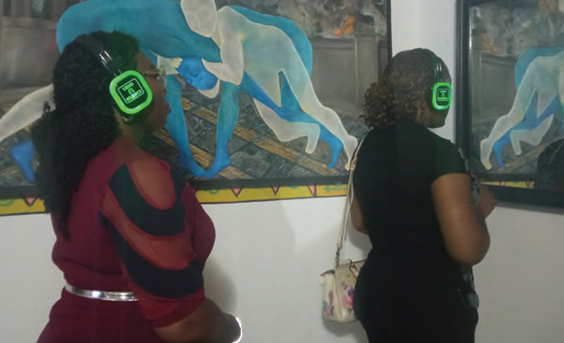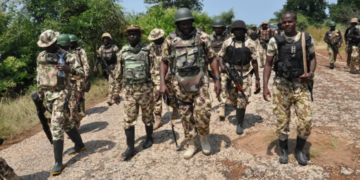In the second edition of the Creative Arts and Visual Imagery Center (CAVIC’s) ‘Creativity & Technology Festival’, art converged with technology to make Nigeria’s cultural heritage accessible to an inter-generational audience, in addition to launching an application, ‘Ojiraeyi’, connecting creatives, techies and professionals of diverse disciplines to foster innovative collaborations that will not only place Nigeria on the global art map, but provide solutions to home-grown problems.
Vastly different from the canvas paintings, data protected fashion accessories and the interactive kinetic sculpture featured at the maiden edition, the festival held November 7 to 9, at the CAVIC Hub, took things up a notch with its exhibition showcases this year. From Bingham University’s ‘Life Painting’, ‘‘Virtual’ & ‘Augmented’ realities Museums’; to medical doctor, Paulcy Odama’s multimedia installation ‘Body Dysmorphia’; and Philip Agbese and Teddy Atuluku’s ‘immersive sound installation’ – enticing viewers into a northern Nigeria folktale, and a ‘portraiture Installation’ that creates hyper realistic images of Nigeria’s historical figures; everything is seemingly geared towards the preservation and accessibility of Nigeria’s cultural heritage.
The exhibition begins with Agbese & Atuluku’s ‘immersive soundscape installation’, which draws the viewer into a kaleidoscope of constellations projected on the walls. The constellation melds into aesthetic architectural designs reminiscent of the north, the begins the pictorial tale of the legend of ‘Bayajidda’. A QR code beside the installation, provides a printed format of the folktale for audience members unfamiliar with the man who defeated a python to ensure access to clean, drinking water for the community that elevated him for his courageous deed.
Next to the immersive installation awaits another one. There, with the aid of AI, hyper-realistic images of a handful of Nigeria’s historical figures like King Jaja of Opobo, Princess Inikpi among others are projected onto a framed portraiture canvas, transforming them from mere abstract names and grainy images into real people.
Above the two installations, is Bingham University’s ‘Life Painting’. Via a neural network computer that deploys machine learning, images of visitors are captured and transformed into stylized artworks within a minute. Although the subjects are featureless, viewers can identify themselves by their stance and clothing.
At a table next to life painting, are two virtual, and augmented reality pieces that take viewers on a ‘VR tour of the northern Nigeria Nok Art’. With the AR App, viewers can focus their mobile Google Lens on a picture book about the Nok Art, which then projects a 3D image of the artefact in focus; and with the aid of a VR headset viewers find themselves standing next to five, six-foot tall Nok artefacts.
Finally, tucked away in the farthest space upstairs is the ‘Body Dysmorphia installation’. This interactive multimedia artwork makes viewers active participants – through a headset that holds the voices of people living with body dysmorphia, narrating their harrowing experiences. By standing before a mirror which converts to 3D, a semi-abstract painting of two grappling bodies, viewer feel the experiences of body dysmorphia survivors, thereby encouraging them, be it in our digital interactive or physical spaces, to be kinder in their words to others, as they don’t know what the other person is going through.
Proud of the festival’s accomplishment this year, festival founder and artistic director, Philip Agbese, highlight challenges encountered in the course of realizing the showcase. They include, the unavailability of basic but crucial equipment requisite to build the immersive spaces, to the importation of same equipment which cost money, time and energy.
“Had these technologies been in use in the country, they would not be so expensive, thus easy to access,” said Agbese.
These challenges however are tied-in to the festival’s objective to foster innovative collaborations between creatives and techies, to enhance the creation of global tech-art practice in Nigeria. Hence, the relevance of CAVIC’s new app ‘Ojiraeyi’ set to launch on Google Play Store in a week.
Translated as ‘a gathering’ in the Idoma tribe of Benue State, ‘Ojiraeyi’, will convene likeminded people, particularly creatives and techies from different parts of the globe, to network, collaborate and innovate projects that provide solutions to real-life problems as well as place Nigerian art on the global stage.
‘Ojiraeyi’ sans the compounding stress of a physical meeting, and the intensive digital search for likeminded collaborators.
“This app has been a long time coming. A major challenge we found when we kickstarted this festival was the misunderstanding between the creatives and the tech professionals. The creatives always find it difficult to work with tech guys, whom they accuse of attempts to rush their creative processes. Conversely, the tech guys are not willingly to spend a lot of time in non-profitable projects.
“With the app, you can find likeminded people to collaborate with you on your idea, and get help on how to improve it. Who knows we might have the next Elon Musk from this venture,” said Agbese.
The app is currently on its final testing stage to protect its users from fraudsters, hackers and malware attacks, before launching on Google Play Store in a week.
“We also have our own back-end security to monitor and shutoff troublemakers, who are up to no good from the platform,”
Themed ‘Interactive Futures: Building Realities’, the Creativity & Technology Festival has come a long way and is taking seminal steps towards the building of tech-fused artworks and products that actual solve real-life local problems.










